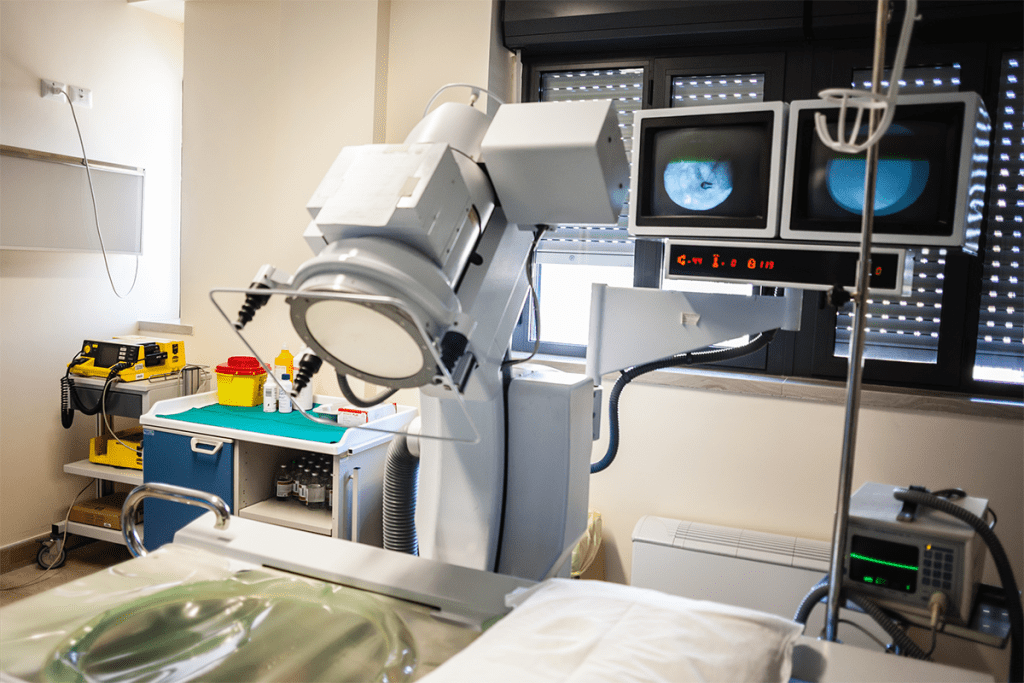Last Updated on October 31, 2025 by
Figuring out if Extracorporeal Shock Wave Lithotripsy (ESWL) treatment was successful is key for those with kidney stones. At Liv Hospital, we employ cutting-edge medical methods to check if ESWL worked well.

Doctors look at the stone-free rate (SFR), follow-up scans, and if symptoms go away to see if ESWL was effective. This non-invasive method uses shockwaves to smash stones in the kidneys, ureters, or bladder.
We dive into what makes ESWL successful. This includes the stone’s size, where it is, and the patient’s age. Knowing these details helps us see if ESWL was a success.
ESWL, or Extracorporeal Shock Wave Lithotripsy, is a non-invasive treatment for kidney stones. It has changed how we treat nephrolithiasis. It offers a non-surgical way to remove stones, unlike old methods.
ESWL uses shockwaves to break down stones in the kidneys, ureters, or bladder. These shockwaves are made outside the body and focused on the stone. This breaks the stone into smaller pieces that can pass through the urinary tract.
This treatment is done on an outpatient basis. It doesn’t need surgical cuts, making it a good choice for many patients.

Research on NCBI shows ESWL works well for some stones. It’s effective for stones in the upper and middle ureters, with success rates of 82% to 90%. For stones in the lower ureter, success rates are lower, from 58% to 67%.
ESWL is used for:
The success of ESWL depends on the stone’s size, type, and location, and the patient’s health. Knowing these factors helps doctors predict how well the treatment will work.
At our institution, we focus on the latest treatments for kidney stones and other urinary tract issues. Our team aims to provide top-notch care and support for patients from around the world.
Successful lithotripsy is shown by certain results that show the treatment works well. At Liv Hospital, we watch these signs closely. This ensures our patients get the best results from Extracorporeal Shock Wave Lithotripsy (ESWL).
The stone-free rate (SFR) shows if ESWL was successful. We found that SFR is almost 99% for stones up to 10 mm after three months. This means most small stones are successfully treated.
Smaller stones and younger patients tend to have better SFR. These are important factors in predicting success.

When symptoms like pain go away, it’s a sign of successful lithotripsy. Patients often feel better after treatment. Knowing what lithotripsy means and the lithotripsy definition are helps those thinking about shockwave lithotripsy.
We look at patient age and stone size to predict success. Younger patients and those with smaller stones do better. This helps us make treatment plans that fit each patient’s needs.
After ESWL, or extracorporeal shock wave lithotripsy, it’s key to check how well the treatment worked. At Liv Hospital, we make sure to do follow-up imaging. This helps us see if the kidney stones are gone.
We use ultrasound and CT scans to check how ESWL did. These tools help us see if the treatment was a success. They also tell us if we need to do more.
We use different imaging methods to see how ESWL worked. Ultrasound is often first because it’s safe and doesn’t use radiation. But sometimes, CT scans are used for a more detailed look.
Which imaging we choose depends on the patient’s health, the stone’s size and location, and the doctor’s opinion.
Understanding imaging results after ESWL takes skill and knowledge. We look for signs that the stones are gone. We also check if the patient’s symptoms have improved.
About 46.7% of patients don’t have stones left after one ESWL session. But some might need more treatment or other procedures to clear all stones.
By using the latest imaging and our expertise, we give our patients the best care after ESWL.
Knowing how well ESWL works for various stone types and sizes is key to planning treatments. At Liv Hospital, we focus on treatments that fit each patient’s unique needs.
ESWL has a success rate of 82% to 90% for stones in the upper and middle ureter. This makes ESWL a top choice for these areas. The ESWL procedure works well here because it targets shock waves precisely.
For stones at the end of the ureter, ESWL’s success rate is 58% to 67%. Though lower than for other areas, ESWL is a good option because it’s non-invasive.
The size of the stone greatly affects ESWL’s success. Stones ≤10 mm have a 99% success rate after three months. This shows how well lithotripsy for kidney stones works for smaller stones.
Doctors say, “The success of ESWL depends on the stone’s location and size.” This shows why choosing the right treatment for each patient is so important.
“The effectiveness of ESWL in treating nephrolithiasis is well-documented, with success rates influenced by factors such as stone size and location.”
At Liv Hospital, we aim to provide top-notch healthcare. We offer full support and guidance to international patients. Our team works hard to make sure each patient gets the best treatment plan for them.
ESWL results depend on several factors. These include the patient, the stone, and the technical aspects of the procedure. Knowing these factors helps improve treatment success.
Patient age is a big factor in ESWL success. Younger patients often have better results than older ones. This is because younger people usually have better health and fewer health issues.
Key patient-related factors include:
The size, type, and density of the stone matter a lot. Smaller stones are easier to treat with ESWL. Stones less than 10 mm have a 99% success rate after three months.
Important stone-related factors are:
The technical details of ESWL, like the lithotripter type and the operator’s skill, affect results. Our team is well-trained and experienced in ESWL.
Technical factors that play a critical role include:
We adjust ESWL treatment based on these factors to meet each patient’s needs. At Liv Hospital, we aim to provide top-notch care and the best possible results for ESWL patients.
Knowing when to check if ESWL works is key to seeing how well it treats a problem. At Liv Hospital, we keep a close eye on our patients. This helps us get the best results from ESWL.
Right after the first ESWL session, we check how well it worked. 46.7% of patients are stone-free after the first ESWL treatment. We use imaging to see if the treatment was a success.
We have follow-up plans to see how patients are doing after ESWL. At three months, we check if any stones are left. This is important for knowing if the extra shock wave therapy worked.
Checking in over time is important to see if ESWL really works. We keep an eye on patients for a long time. We look at things like if stones come back and how patients are overall.
By following this timeline, we can really see if ESWL is working. This helps us make the best choices for our patients’ care.
Up to half of the patients who get Extracorporeal Shock Wave Lithotripsy (ESWL) might not have all the stones cleared. At Liv Hospital, we know that getting rid of all stones can be a long and complex journey. It might take more than one treatment.
Not all patients get rid of all stones after ESWL, which happens in up to 50% of cases. This can be because of the stone’s size, type, and how dense it is. It can also depend on the patient’s age and body shape.
Signs that more treatment is needed include ongoing pain or blood in the urine. Also, if scans show that there are stones left, more treatment might be necessary.
When more treatment is needed, there are several options. These include:
In some cases, ESWL might be done again. This choice is made if there are stones left that could cause problems later. The size and location of these stones, along with the patient’s health, play a big role in this decision.
At Liv Hospital, we focus on giving each patient the care they need, even if they need more treatment after ESWL. Our team works with each patient to find the best treatment plan. This ensures they get the care that works best for them.
To see if ESWL worked, doctors look at the stone-free rate, follow-up scans, and if symptoms stay gone. At Liv Hospital, we aim to give top-notch healthcare. We support and guide international patients fully.
ESWL is a safe and effective way to treat many types of stones. Our team works hard to help patients get the best care. Success with ESWL depends on the stone’s size, type, and the patient’s health.
We use the latest in lithotripsy to get the best results for our patients. We focus on giving great care at every step. This includes helping patients from the start to long after treatment.
ESWL, or Extracorporeal Shock Wave Lithotripsy, is a non-invasive treatment. It uses shock waves to break up stones in the kidney or ureter. This makes it easier for the stones to pass out of the body.
Successful lithotripsy is shown by the stone-free rate (SFR) and symptom resolution. Our experts watch these closely to ensure the best results.
We use advanced imaging like X-rays, CT scans, and ultrasounds. These help us see if ESWL worked and if there are any stones left.
Success rates for ESWL depend on the stone’s location and size. For example, stones in the upper and middle ureter have an 82-90% success rate. But stones in the lower ureter have a 58-67% success rate.
Several things can impact ESWL success. These include the patient’s age, the stone’s size and type, and how well the procedure is done.
We check ESWL success at first, then after three months. We also look at long-term results to see how well the treatment worked.
More treatment might be needed if not all stones are cleared. In such cases, other treatments or even more ESWL might be considered.
About 46.7% of patients are stone-free after their first ESWL session. This means nearly half of the patients are free of stones after the first treatment.
Stone size is a big factor in ESWL success. Stones 10 mm or smaller have a 99% success rate after three months.
Subscribe to our e-newsletter to stay informed about the latest innovations in the world of health and exclusive offers!